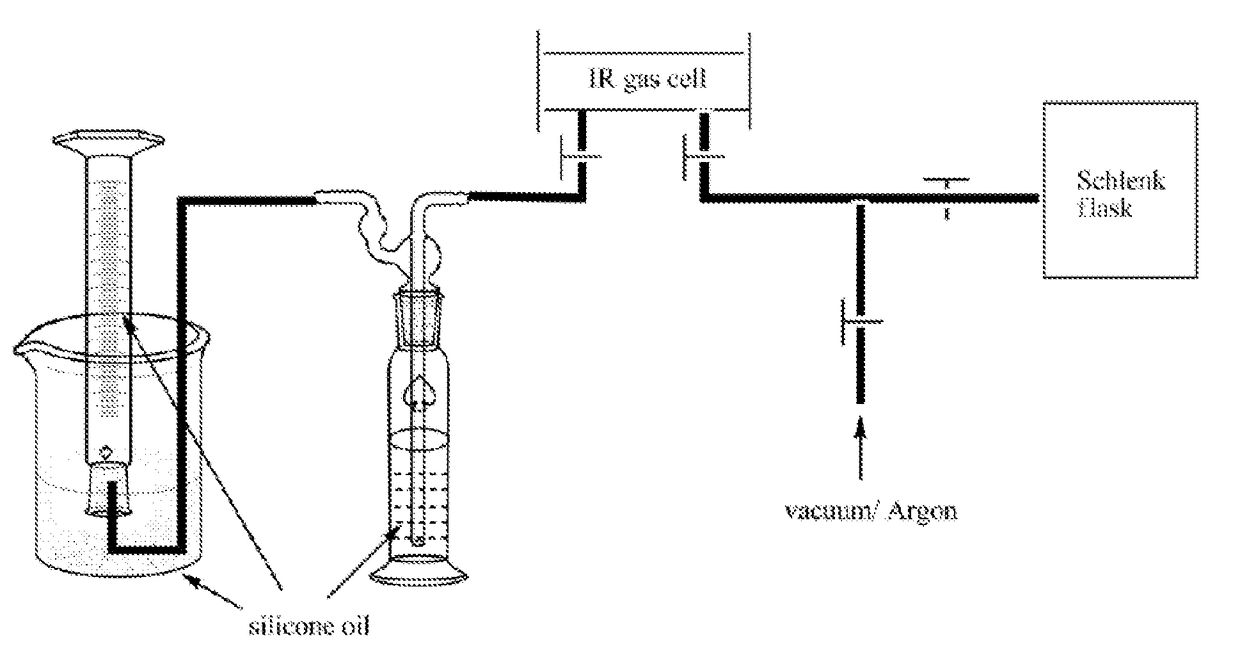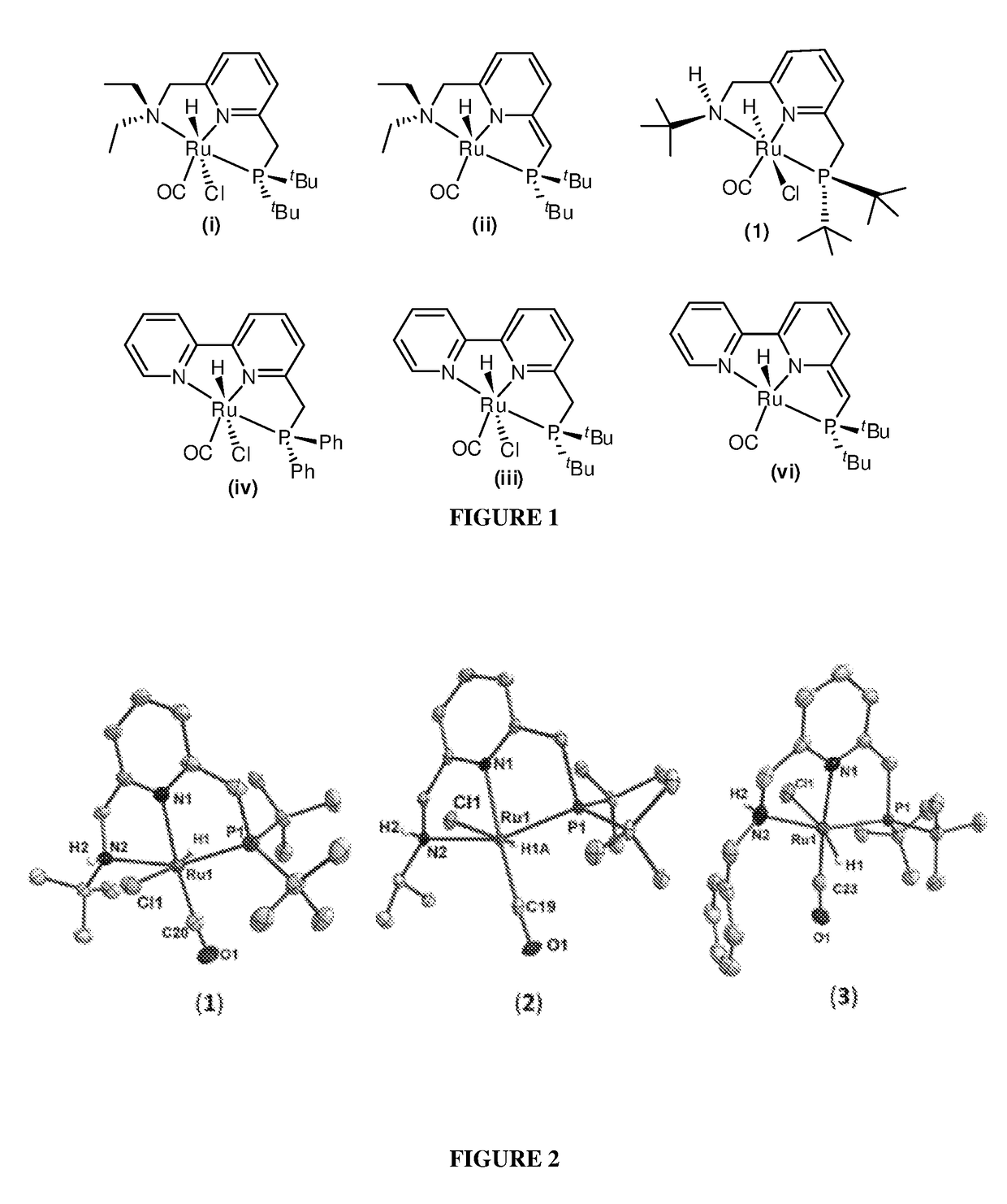Liquid-organic hydrogen carrier systems based on catalytic peptide formation and hydrogenation
- Summary
- Abstract
- Description
- Claims
- Application Information
AI Technical Summary
Benefits of technology
Problems solved by technology
Method used
Image
Examples
example 1
Preparation of Ruthenium Complexes
[0273]The Ruthenium complexes of formulae A1, A2, A3, B1, C1, B2, C2, (i) and (ii) may be prepared in accordance with the methods described in U.S. Pat. No. 8,178,723, the contents of which are incorporated by reference herein in their entirety.
[0274]The Ruthenium complexes of formulae A1′, A2′, A3′, B1′, B2′, C1′, C2′, (a), (b), (c), (iii), (iv), (v) and, (vi) may be prepared in accordance with the methods described in WO 2012 / 052996, the contents of which are incorporated by reference herein in their entirety.
[0275]Ruthenium complexes of formulae A1″, A2″, A3″ and A4″, as well as compounds encompassed by such formulae, are prepared in accordance with the methods described below.
[0276]Three different PNN—H ligands bearing substituents R=tert-butyl (L1), isopropyl (L2) and benzyl (L3) were synthesized by reaction of 2-(ClCH2)-6-(tBu2P(BH3)CH2)pyridine with the corresponding amines viz. tert-BuNH2, ipr-NH2, and benzylamine respectively (Scheme 14). T...
example 2
Preparation of Glycine Anhydride from 2-aminoethanol
[0284]Initially, 2-aminoethanol (AE) was heated at 135° C. under argon for 12 hours in the absence of solvent, using 0.05 mol % of (i) and 1.2 equiv of KOtBu (for generation of the actual catalyst (ii) in situ). No product was observed under these conditions (Table 1, entry 1), perhaps due to practically irreversible binding of the substrate to Ru via the amine group due to the high concentration of the substrate, retarding the required O—H activation. However, using 10 mmol of AE and 0.5 mol % of catalyst (i) with no solvent resulted in 48% conversion to mostly linear peptides, and 25% yield of H2 (entry 2). Using 0.5 mL dioxane as a solvent and catalyst loading to 0.5 mol % resulted in 57% conversion of 2-aminoethanol to give linear peptides as the major products, as observed by 1H NMR spectroscopy and Mass Spectrometry (entry 3). Significantly, when 2 mL dioxane was used as a solvent and 0.5 mol % of catalyst (i) was employed, 6...
example 3
Hydrogenation of Glycine Anhydride to 2-Aminoethanol
[0289]Catalysts (i) and 1 were tested for the hydrogenation of glycine anhydride which is unprecedented for any diketopiperazine. At first, no product was obtained when the reaction was run under 10 bar of H2 in THF using 1 mol % of either complex at 110° C. (oil bath temperature, Table 4, entries 1, 2). Applying 50 bar of H2, 2 mol % complex (i) and 2.4 mol % KOtBu in dioxane at 110° C. resulted in quantitative yield of the linear amide 2-amino-N-(2-hydroxyethyl)acetamide (entry 3). Higher amount of base improved the reaction, with 61% yield of glycine anhydride and 34% yield of 2-amino-N-(2-hydroxyethyl)acetamide were produced when 4.8 mol % KOtBu was applied together with 2 mol % complex (i) (entry 4). Complex 1 showed much better catalytic activity than complex (i) and nearly 100% yield of 2-aminoethanol was obtained, even in a lower complex loading of 0.5 mol % and less amount of solvent (entries 5, 6). Using lower pressure of...
PUM
| Property | Measurement | Unit |
|---|---|---|
| Fraction | aaaaa | aaaaa |
| Equivalent mass | aaaaa | aaaaa |
| Structure | aaaaa | aaaaa |
Abstract
Description
Claims
Application Information
 Login to View More
Login to View More - R&D
- Intellectual Property
- Life Sciences
- Materials
- Tech Scout
- Unparalleled Data Quality
- Higher Quality Content
- 60% Fewer Hallucinations
Browse by: Latest US Patents, China's latest patents, Technical Efficacy Thesaurus, Application Domain, Technology Topic, Popular Technical Reports.
© 2025 PatSnap. All rights reserved.Legal|Privacy policy|Modern Slavery Act Transparency Statement|Sitemap|About US| Contact US: help@patsnap.com



